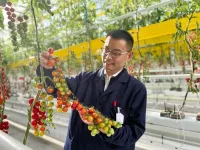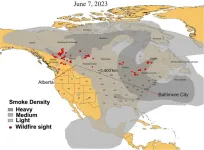A new twist: the molecular machines that loop our chromosomes also twist DNA
2024-12-13
(Press-News.org) A new twist: the molecular machines that loop our chromosomes also twist DNA
Scientists from the Kavli Institute of Delft University of Technology and the IMP Vienna Biocenter discovered a new property of the molecular motors that shape our chromosomes. While six years ago they found that these so-called SMC motor proteins make long loops in our DNA, they now discovered that these motors also put significant twists into the loops that they form. These findings help us better understand the structure and function of our chromosomes. They also provide insight into how disruption of twisted DNA looping can affect health—for instance, in developmental diseases like ‘cohesinopathies’. The scientists published their findings in Science Advances.
The struggle of our cells
Imagine trying to fit two meters of rope into a space much smaller than the tip of a needle—that’s the challenge every cell in your body faces when packing its DNA into its tiny nucleus. To achieve this, nature employs ingenious strategies, like twisting the DNA into coils of coils, so-called ‘supercoils’ (see pictures for a visualisation) and wrapping it around special proteins for compact storage.
Small DNA loops regulate chromosome functions
However, compaction isn’t enough. Cells also need to regulate the chromosome structure to enable its function. For example, when genetic information needs to be accessed, the DNA is locally read off. In particular when it’s time for a cell to divide, the DNA must first unpack, duplicate, and then properly separate into two new cells. Specialised protein machines called SMC complexes (Structural Maintenance of Chromosomes) play a critical role in these processes. Just a few years ago, scientists at Delft and other places discovered that these SMC proteins are molecular motors that make long loops in our DNA, and that these loops are the key regulators of chromosome function.
A new twist
In the lab of Cees Dekker at TU Delft, postdocs Richard Janissen and Roman Bath now provide clues that help to crack this puzzle. They deloped a new way to use ‘magnetic tweezers’ by which they could watch individual SMC proteins make looping steps in DNA. Importantly, they were also able to resolve if the SMC protein would change the twist in the DNA. And strikingly, the team found that it did: the human SMC protein cohesin does indeed not only pull DNA into a loop, but also twists the DNA in a left-handed way by 0.6 turns in each step of creating the loop.
A glimpse into the evolution of SMC proteins
What’s more, the team found that this twisting action isn’t unique to humans. Similar SMC proteins in yeast behave the same way. Strikingly, all the various types of SMC proteins from human and yeast add the same amount of twist – they turn DNA 0.6 times at every at every DNA loop extrusion step. This shows that the DNA extrusion and twisting mechanisms stayed the same for very long times during evolution. No matter whether DNA is looped in humans, yeast, or any other cell – nature employs the same strategy.
Essential clues
These new findings will provide essential clues for resolving the molecular mechanism of this new type of motor. Additionally, they make clear that DNA looping also affects the supercoiling state of our chromosomes, which directly affects processes like gene expression. Finally, these SMC proteins are related to various diseases such as Cornelia de Lange Syndrome, and a better understanding of these processes is vital for tracking down the molecular origins of these serious illnesses.
Publication:
R. Janissen1,*, R. Barth1,*, I. F. Davidson2, J.-M. Peters2, C. Dekker1,†. All eukaryotic SMC proteins induce a twist of -0.6 at each DNA-loop-extrusion step, Science Advances, DOI 10.1126/sciadv.adt1832
Affiliations: 1 Department of Bionanoscience, Kavli Institute of Nanoscience Delft, Delft University of Technology, Delft, Netherlands. 2 Research Institute of Molecular Pathology, Vienna BioCenter, Vienna, 1030, Austria. *These authors contributed equally to this work. †Corresponding author: c.dekker@tudelft.nl
END
ELSE PRESS RELEASES FROM THIS DATE:
2024-12-13
The air around us contains a powerful solution for making agriculture more sustainable. Researchers at Stanford University and King Fahd University of Petroleum and Minerals in Saudi Arabia have developed a prototype device that can produce ammonia – a key fertilizer ingredient – using wind energy to draw air through a mesh. The approach they developed, if perfected, might eliminate the need for a century-old method that produces ammonia by combining nitrogen and hydrogen at high pressures and temperatures. The older method consumes 2% of global energy and contributes 1% of annual carbon dioxide emissions from its ...
2024-12-13
An international team of researchers, including a glaciologist at Newcastle University, UK, has discovered remarkably well-preserved glacial landforms buried almost 1 km beneath the North Sea.
The team used sound wave, known as seismic, data to reveal Ice Age landforms buried beneath almost 1 km of mud in the North Sea. The results, reported in the journal Science Advances, suggest that the landforms were produced about 1 million years ago, when an ice sheet centred over Norway extended towards the British Isles.
This is important because the timing of this ice advance corresponds to a period of global cooling called the Mid-Pleistocene Transition.
Glacial ...
2024-12-13
About The Study: Among patients with early or locally advanced triple-negative breast cancer, the addition of camrelizumab, an anti–PD-1 antibody, to neoadjuvant chemotherapy significantly improved pathological complete response.
Corresponding Authors: To contact the corresponding authors, email Zhi-Ming Shao, MD (zhiminshao@fudan.edu.cn) and Lei Fan, MD (teddyfl@163.com).
To access the embargoed study: Visit our For The Media website at this link https://media.jamanetwork.com/
(doi:10.1001/jama.2024.23560)
Editor’s Note: Please see the article for additional information, including ...
2024-12-13
Intermittent fasting has proven benefits for metabolic health, but a new study shows that it could slow hair growth—at least in mice. Researchers report December 13 in the Cell Press journal Cell that mice subjected to intermittent fasting regimes showed improved metabolic health but slower hair regeneration compared to mice with 24/7 access to food. A similar process might occur in humans, based on a small clinical trial that the team also conducted, but it’s likely to be less severe since humans have a much slower metabolic rate and different hair growth patterns compared to mice.
“We don't want to scare people away ...
2024-12-13
About The Study: The findings of this study suggest that body mass index and obesity prevalence in the U.S. decreased in 2023 for the first time in more than a decade. The most notable decrease was in the South, which had the highest observed per capita glucagon-like peptide 1 receptor agonist (GLP-1RA) dispensing rate. However, dispensing does not necessarily mean uptake, and the South also experienced disproportionately high COVID-19 mortality among individuals with obesity.
Corresponding Author: To contact the corresponding author, Benjamin Rader, PhD, MPH, email benjamin.rader@childrens.harvard.edu.
To ...
2024-12-13
About The Study: In 2023, among 29,522 respondents to the National Health Interview Survey, a nationally representative household survey, 8.4% of adults in the U.S. reported they ever had post–COVID-19 condition (PCC; also known as long COVID), 3.6% currently had PCC, and 2.3% currently had activity-limiting PCC. Significant differences across all 3 outcomes were observed by sex, sexual orientation, age, race and Hispanic origin, family income, and urbanization.
Corresponding Author: To contact the corresponding author, Anjel Vahratian, PhD, MPH, email avahratian@cdc.gov.
To access the embargoed study: Visit our For The Media website ...
2024-12-13
A recent study has reported a novel breeding strategy to rapidly create climate-smart crops that show higher yield under normal conditions and greatly rescue yield losses under heat stress both in staple grain and vegetable crops.
The study, which was published in Cell on 13 December, was conducted by Prof. XU Cao’s team from the Institute of Genetics and Developmental Biology (IGDB) of the Chinese Academy of Sciences.
The year 2050 is fast approaching and farm productivity must increase by 60% in order to feed a projected global population of 10 billion. However, current crop production is insufficient and is expected to worsen due to the abiotic-stress burden ...
2024-12-13
Led by researchers from the University of Oxford’s Leverhulme Centre for Demographic Science and the University of Iceland, the review explores how genetic variations can explain differences in reproductive health and longevity.
The study provides the most comprehensive review of male and female genetic discoveries of reproductive traits to date, and provides new insights into how our DNA affects when we have children, the timing of menopause, and even how that is connected to how long we live.
Genes at the heart of reproduction
Using the GWAS Catalog, an online database of Genome Wide Association Studies (GWAS), the researchers identified ...
2024-12-13
Wildfire smoke has long been known to exacerbate health problems like heart disease, lung conditions, and asthma, but now a new study finds that smoke from these fires can lead to poor health thousands of miles away. Researchers from the University of Maryland Institute for Health Computing (UM-IHC) found that medical visits for heart and lung problems rose by nearly 20 percent during six days in June, 2023, when smoke from Western Canadian wildfires drifted across the country, leading to very poor air quality days in Baltimore and ...
2024-12-13
PASADENA, CA – December 13, 2024 – The Giant Magellan Telescope announced today that Northwestern University has joined its international consortium to construct the $2.54 billion observatory.
Home to the world-renowned Center for Interdisciplinary Exploration and Research in Astrophysics (CIERA) and the newly founded NSF-Simons AI Institute for the Sky (SkAI), Northwestern is at the forefront of advancing astrophysical research. Northwestern researchers will develop and apply cutting-edge artificial intelligence ...
LAST 30 PRESS RELEASES:
[Press-News.org] A new twist: the molecular machines that loop our chromosomes also twist DNA


